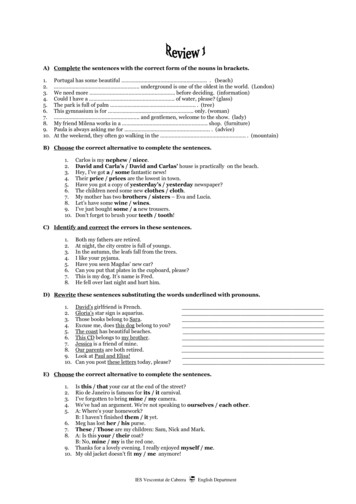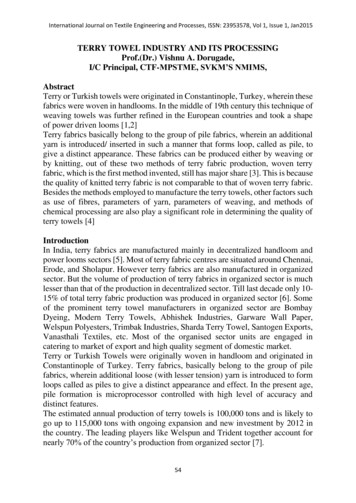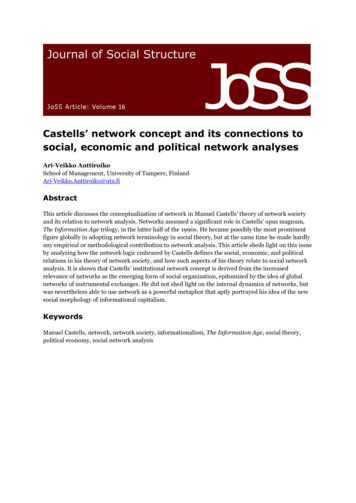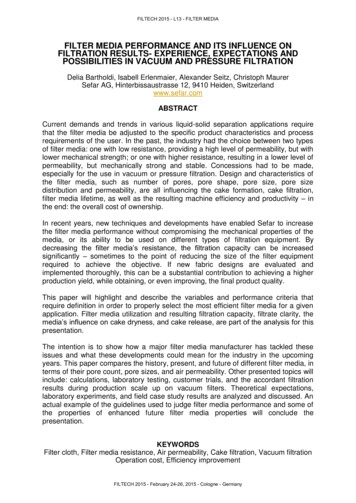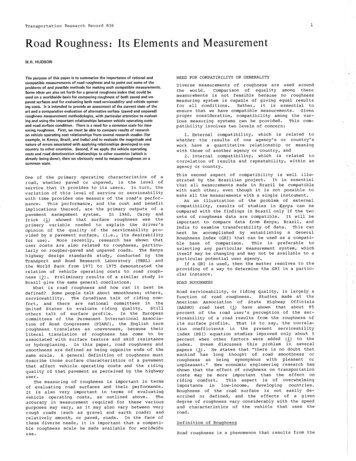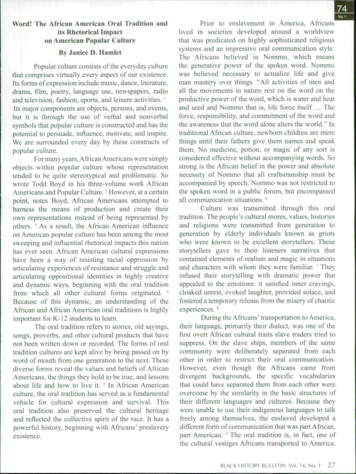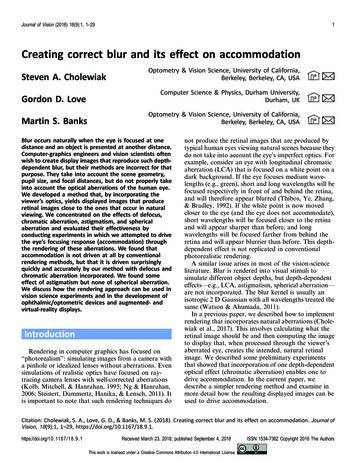
Transcription
Journal of Vision (2018) 18(9):1, 1–291Creating correct blur and its effect on accommodationOptometry & Vision Science, University of California,Berkeley, Berkeley, CA, USA# Gordon D. LoveComputer Science & Physics, Durham University,Durham, UK# Martin S. BanksOptometry & Vision Science, University of California,Berkeley, Berkeley, CA, USA# Steven A. CholewiakBlur occurs naturally when the eye is focused at onedistance and an object is presented at another distance.Computer-graphics engineers and vision scientists oftenwish to create display images that reproduce such depthdependent blur, but their methods are incorrect for thatpurpose. They take into account the scene geometry,pupil size, and focal distances, but do not properly takeinto account the optical aberrations of the human eye.We developed a method that, by incorporating theviewer’s optics, yields displayed images that produceretinal images close to the ones that occur in naturalviewing. We concentrated on the effects of defocus,chromatic aberration, astigmatism, and sphericalaberration and evaluated their effectiveness byconducting experiments in which we attempted to drivethe eye’s focusing response (accommodation) throughthe rendering of these aberrations. We found thataccommodation is not driven at all by conventionalrendering methods, but that it is driven surprisinglyquickly and accurately by our method with defocus andchromatic aberration incorporated. We found someeffect of astigmatism but none of spherical aberration.We discuss how the rendering approach can be used invision science experiments and in the development ofophthalmic/optometric devices and augmented- andvirtual-reality displays.IntroductionRendering in computer graphics has focused on‘‘photorealism’’: simulating images from a camera witha pinhole or idealized lenses without aberrations. Evensimulations of realistic optics have focused on raytracing camera lenses with well-corrected aberrations(Kolb, Mitchell, & Hanrahan, 1995; Ng & Hanrahan,2006; Steinert, Dammertz, Hanika, & Lensch, 2011). Itis important to note that such rendering techniques donot produce the retinal images that are produced bytypical human eyes viewing natural scenes because theydo not take into account the eye’s imperfect optics. Forexample, consider an eye with longitudinal chromaticaberration (LCA) that is focused on a white point on adark background. If the eye focuses medium wavelengths (e.g., green), short and long wavelengths will befocused respectively in front of and behind the retina,and will therefore appear blurred (Thibos, Ye, Zhang,& Bradley, 1992). If the white point is now movedcloser to the eye (and the eye does not accommodate),short wavelengths will be focused closer to the retinaand will appear sharper than before, and longwavelengths will be focused farther from behind theretina and will appear blurrier than before. This depthdependent effect is not replicated in conventionalphotorealistic rendering.A similar issue arises in most of the vision-scienceliterature. Blur is rendered into visual stimuli tosimulate different object depths, but depth-dependenteffects—e.g., LCA, astigmatism, spherical aberration—are not incorporated. The blur kernel is usually anisotropic 2 D Gaussian with all wavelengths treated thesame (Watson & Ahumada, 2011).In a previous paper, we described how to implementrendering that incorporates natural aberrations (Cholewiak et al., 2017). This involves calculating what theretinal image should be and then computing the imageto display that, when processed through the viewer’saberrated eye, creates the intended, natural retinalimage. We described some preliminary experimentsthat showed that incorporation of one depth-dependentoptical effect (chromatic aberration) enables one todrive accommodation. In the current paper, wedescribe a simpler rendering method and examine inmore detail how the resulting displayed images can beused to drive accommodation.Citation: Cholewiak, S. A., Love, G. D., & Banks, M. S. (2018). Creating correct blur and its effect on accommodation. Journal ofVision, 18(9):1, 1–29, https://doi.org/10.1167/18.9.1.https://doi.org/1 0. 11 67 /1 8 .9 .1Received March 23, 2018; published September 4, 2018This work is licensed under a Creative Commons Attribution 4.0 International License.ISSN 1534-7362 Copyright 2018 The Authors
Journal of Vision (2018) 18(9):1, 1–29Cholewiak, Love, & BanksAccommodationAccommodation is a control system that adjusts thepower of the eye’s crystalline lens to maintain a sharpretinal image. In control systems, an error signal withmagnitude and sign information is an odd-error signal(Eykhoff, 1972). A signal with magnitude but no signinformation is even-error. Blur due to defocus is aneven-error signal: identical whether the object creatingthe out-of-focus image is farther or nearer than wherethe eye is accommodated. If only defocus blur wereused to guide accommodation, the initial direction ofcorrective response could only be random. But after theinitial response, the system could determine if blur hasincreased or decreased, and then adjust the lens toeventually attain a sharp retinal image. Thus, evenerror signals would necessarily produce trial-and-errorbehavior as when focusing a microscope or binoculars(Stark & Takahashi, 1965).The even-error problem in accommodation might besolved under everyday circumstances by using otherdepth information such as binocular vergence. Whenan object draws nearer, the eyes must converge tomaintain a single image, and the vergence response candrive accommodation in the right direction (Cumming& Judge, 1986; Schor, 1992). Many other depth cues(size change, occlusion, motion parallax, texturegradient, etc.) could also provide useful information.This point was made by Stark and Takahashi (1965):This lack of a simple optical odd-error signal maybe of little functional significance in everydayvision. In such a situation a person usuallyaccommodates in association with convergence,while perceiving a highly structured image withmany reinforcing perceptual clues and accommodates in a direction which may also have beenpredicted by the recent past history of the spatialenvironment. (p. 146)This argument is misleading. Vergence and the othercues are ancillary cues for accommodation: They arecorrelated with the changes in focal distance to whichthe system responds. But none of them can guideaccommodation accurately because they cannot directly specify whether the retinal image is sharplyfocused or not. An example helps make this point.Imagine a control system for maintaining the temperature of a room. When the temperature is too low, thethermostat senses it, and the heater is activated untilthe temperature has reached the desired value. Whentemperature is too high, the air conditioner is turnedon, and so forth. There are many ancillary cues that arepredictive of the adjustment that will be needed. Forexample, the clock can inform the system that it isnighttime, so the heater should be turned on. But none2of these ancillary cues would be used by themselves tocontrol the room environment because they are tooinaccurate as predictors. Rather the control variableshould be the temperature measured by a thermometer.In general, control systems work best as negativefeedback systems in which the effector is constantlyadjusted in the face of varying input to attain a targetoutput value. Without such a negative-feedback loop,changes in the relationships between the input, effector,and output lead to erroneous adjustments. Theaccommodative system could never become properlycalibrated to maintain image sharpness if it relied onlyon the above ancillary cues because none of them aredirectly informative of the lens power required tomaximize sharpness. For this reason, the system shouldcreate negative feedback by monitoring retinal-imagesharpness because this allows it to recalibrate as the eyegrows, the pupil changes size, the lens becomes lesselastic, etc. It is not surprising then to find that the eyedoes in fact accommodate accurately when ancillarydepth cues are stripped away.This was demonstrated elegantly by Smithline(1974). He presented a stimulus in best focus and thenstepped it nearer or farther from the eye and measuredthe accommodative response. The stimulus was viewedmonocularly, so binocular disparity could not be usedto determine the direction of change. Head positionwas fixed, so motion parallax could not be used. Thestimulus was presented in a Badal lens system, so therewas no change in image size. The only informativesignal was the blur of the retinal image. Strikingly, thefirst measurable response was always in the rightdirection: The eye knew the direction it needed to go torefocus the image. We will refer to this as the OpticalBlur condition. Smithline then calculated the blurcaused by the change in stimulus distance and insertedthat blur into the stimulus by introducing a diffusionscreen. In this case, of course, no accommodativeresponse could restore the retinal image to its initialclarity. We will refer to this as the Rendered Blurcondition. Interestingly, Smithline now observed noresponse, which means that the eye knew that nothingcould be gained by changing focus when the blur wasrendered rather than optically induced. These resultsshow that with optically induced blur the retinal imagecontains odd-error information that is used to solve theproblem of the direction and magnitude of responserequired to maximize retinal-image sharpness. Theresults have stood the test of time (Kruger, Mathews,Aggarwala, & Sanchez, 1993; Kruger, Mathews,Aggarwala, Yager, & Kruger, 1995; Stone, Mathews, &Kruger, 1993; Chen, Kruger, Hofer, Singer, & Williams, 2006).Three image-based signals could potentially provideodd-error information: higher-order aberrations, micro-fluctuations, and longitudinal chromatic aberra-
Journal of Vision (2018) 18(9):1, 1–29Cholewiak, Love, & Bankstion. We describe these signals below, but first describethe properties of defocus.DefocusDefocus is caused by the eye being focused at adifferent distance than an object. Presumably, the roleof accommodation is to minimize defocus. The pointspread function (PSF) due to defocus alone (ignoringdiffraction) is a cylinder whose diameter depends on thediameter of the viewer’s pupil and where the eye isfocused relative to the object causing defocus. The PSFdiameter (for one wavelength) is given to closeapproximation by 11 b ¼ A ¼ AjDDj ð1Þz0 z1where b is in radians, A is pupil diameter in meters, z0 isdistance to which the eye is focused, z1 is distance to theobject creating the blurred image, and DD is thedifference in those distances in diopters (Held, Cooper,O’Brien, & Banks, 2010). Importantly, the PSF due todefocus alone is identical whether the object is fartheror nearer than the eye’s current focus distance. This isillustrated in Figure 1, which shows the PSFs due todefocus plus diffraction for various accommodativeerrors. They are identical for positive and negativeerrors. Thus, appropriate rendering of defocus alone isthe same for far and near parts of the scene.Higher-order aberrations and astigmatismThe eye’s optical imperfections (apart from diffraction and scatter) can be described by deviations from aperfect sphere of the wavefront exiting the eye’sfocusing elements and converging on the retina. Thosedeviations are generally classified by Zernike polynomials. In most eyes, the Zernike terms of defocus andastigmatism constitute over 90% of the total deviationfrom an ideal optical system (Porter, Guirao, Cox, &Williams, 2001; Plainis & Pallikaris, 2008). The otherterms are higher order aberrations (HOAs) and arequite small and possibly insignificant.AstigmatismAstigmatism occurs when rays propagating inperpendicular planes through the eye are focused atdifferent distances. Measurable astigmatism occurs inthe majority of adults (Satterfield, 1989). Its magnitudeand axis vary across individuals. In most people themagnitude is not large enough to warrant opticalcorrection (Katz, Tielsch, & Sommer, 1997). The PSFof a defocused astigmatic eye is elliptical with the major3axis in one direction when the object is farther thancurrent focus and with the major axis rotated by 908when the object is nearer than current focus (Figure 1).Thus, astigmatism could provide odd-error information to help guide accommodation in the correctdirection.Spherical aberrationA perfect optical system focuses central and peripheral rays to a point in the image. When accommodatedfar, human eyes exhibit positive spherical aberration:Peripheral rays are focused in front of the retina whencentral rays are focused at the retina (Cheng et al.,2004; López-Gil et al., 2007). Spherical aberration thuscreates different PSFs for objects farther as opposed tonearer than the eye’s current focus (Figure 1; Wilson,Decker, & Roorda, 2002; Thibos, Bradley, Liu, &López-Gil, 2013). This signal could therefore provideodd-error information to guide accommodation in theright direction. As the eye accommodates nearer,spherical aberration shifts toward negative values(Cheng et al., 2004; Tarrant, Roorda, & Wildsoet,2010).Some research has investigated whether HOAs areused to drive accommodation. Most have comparedaccommodation with and without correction of variousHOAs. The results are inconclusive. Fernández andArtal (2005) compared responses when HOAs were notcorrected to responses when all HOAs (except sphericalaberration) were corrected. Correction had essentiallyno effect. Gambra, Sawides, Dorronsoro, and Marcos(2009) also compared responses with and without HOAcorrection and found that some subjects exhibitedslightly more accurate accommodation when HOAswere corrected. Chen et al. (2006) also comparedresponses with and without correction. One subjectcould not accommodate in any condition, four were ableto accommodate but were unaffected by HOA correction, and one was able to accommodate but responseswere less accurate and slower with HOAs corrected.Chin, Hampson, and Mallen (2009a) measured responses with various combinations of HOAs correctedor not. One of five subjects exhibited degradation ofaccommodation in one of four conditions in whichHOAs were fully or partially corrected. Chin, Hampson,and Mallen (2009b) examined responses when the evenorder Zernike terms (providing odd-error signals foraccommodation) were reversed such that those termsindicated that the eye should accommodate in onedirection while defocus indicated that it should accommodate in the other direction. In one of two conditions,two of four observers accommodated initially in thedirection specified by the reversed HOAs. Thus, HOAsmay be used to drive accommodation in some conditionsin some individuals.
Journal of Vision (2018) 18(9):1, 1–29Cholewiak, Love, & Banks4Figure 1. Retinal point-spread functions (PSFs) for defocus alone and defocus plus specific aberrations. Defocus from left to right is 1.0 to þ1.0 D (hyperopic focus is negative). Pupil diameter is 4 mm; wavelength is 520 nm for the top three rows and 449, 520, and617 nm for the bottom row. Diffraction is included. Top row: Defocus plus diffraction. Second row: Astigmatism with magnitude of 0.5D and axis of 1808. Third row: Spherical aberration of 0.29lm. Bottom row: Longitudinal chromatic aberration. Intensities have beengamma expanded (c ¼ 5) to aid visibility.DiffractionDiffraction arises from the wave nature of light.When a beam of light passes through an aperture suchas the pupil, the beam spreads to create a PSF calledthe Airy pattern. The intense region in the center of thepattern is the Airy disk, which has a diameter ofb¼2:44kAð2Þwhere again b is the diameter in radians, k iswavelength in meters, and A is pupil diameter inmeters. The effect of diffraction is small except at smallpupil diameters, which only occur under very ations (MFs) are involuntary variationsin focal power of ;0.25–0.5 D (Collins, 1939; Arnulf,Dupuy, & Flamant, 1951; Winn & Gilmartin, 1992;Charman & Heron, 1988, 2015). There are high- andlow-frequency variations at 1–2 Hz and ;0.6 Hz,respectively. The consensus is that high frequencies aredriven by cardiopulmonary responses while low fre-
Journal of Vision (2018) 18(9):1, 1–29Cholewiak, Love, & Banksquencies are driven by ciliary muscle action on the lens(Winn, Pugh, Gilmartin, & Owens, 1990; Collins,Davis, & Wood, 1995; Walsh & Charman, 1988). MFscould create a directional signal for accommodation(Alpern, 1958; Campbell, Robson, & Westheimer,1959; Charman & Tucker, 1978; Kotulak & Schor,1986; Walsh & Charman, 1988). If the eye were out offocus, a fluctuation in one direction would sharpen theretinal image, while a fluctuation in the other directionwould blur it further. From the difference, the directionthe eye should respond could be determined. Some ofthe earliest adaptive-optics systems for imagingthrough the atmosphere used exactly this principle,which is known as multidither (O’Meara, 1977).There have been hundreds of investigations of MFs(Gray, Winn, & Gilmartin, 1993a,Stark & Atchison,1997; Gray, Winn, & Gilmartin, 1993b; Denieul &Corno-Martin, 1994; Niwa & Tokoro, 1998; Day,Gray, Seidel, & Strang, 2009; Toshida, Okuyama, &Tokoro, 1998; Heron & Schor, 1995; Seidel, Gray, &Heron, 2005; Harb, Thorn, & Troilo, 2006; Langaas etal., 2008; Winn et al., 1990). Despite this mass of data,we are aware of no studies that directly tested whetherMFs are actually used in accommodative control. Thedecisive experiment has not been done because propermanipulation of MFs is technically quite challenging.Chromatic aberrationThe eye’s refracting elements have different refractiveindices for different wavelengths yielding chromaticaberration. As shown in Figure 2, short wavelengths (e.g.,blue) are refracted more than long wavelengths (red), soblue and red images tend to be focused respectively infront of and behind the retina. The wavelength-dependentdifference in focal distance is longitudinal chromaticaberration (LCA). In diopters:633:46ð3Þk 214:10where k is in nanometers and 520 nm is in-focus(Marimont & Wandell, 1994). From 400–700 nm, thedifference is ;2.5 D. LCA is essentially the same in allhuman eyes (Nakajima, Hiraoka, Hirohara, Oshika, &Mihashi, 2015; Thibos et al., 1992).When the eye views a depth-varying scene, LCAproduces different color effects (e.g., colored fringes) fordifferent object distances relative to the current focusdistance. For example, when the eye is focused on a whitepoint, green is sharp in the retinal image and red and blueare not, so a purple fringe is seen around a sharp greenishcenter. But when the eye is focused nearer than the whitepoint, the image has a sharp red center surrounded by ablue-green fringe. For far focus, the opposite occurs(Figure 1). Thus, LCA can in principle indicate whetherDðkÞ ¼ 2:071 5Figure 2. Longitudinal chromatic aberration of the human eyeplotted as relative defocus in diopters as a function ofwavelength. The dotted curve is the aberration of the chromaticeye model of Thibos et al. (1992). The data were adjusted suchthat defocus is zero at 520 nm (dashed vertical line); seeEquation 3. Data have been replotted from Wald and Griffin(1947), Bedford and Wyszecki (1957), Charman and Jennings(1976), Millodot (1976), Powell (1981), Lewis, Katz, andOehrlein (1982), Ware (1982), Mordi and Adrian (1985),Howarth and Bradley (1986), Cooper and Pease (1988),Howarth, Zhang, Bradley, Still, & Thibos (1988), Fernández et al.(2005), and Wang, Candy, Teel, & Jacobs (2008).the eye is well focused and, if it is not, in which direction itshould accommodate to restore sharp focus.The eye’s chromatic aberration also produces lateraleffects in which different wavelengths are imaged atdifferent positions on the retina (Thibos, Bradley, Still,Zhang, & Howarth, 1990). This transverse chromaticaberration is not depth-dependent like LCA
A similar issue arises in most of the vision-science literature. Blur is rendered into visual stimuli to simulate different object depths, but depth-dependent effects—e.g., LCA, astigmatism, spherical aberration— are not incorporated. The blur kernel is usually an isotropic 2 D G

